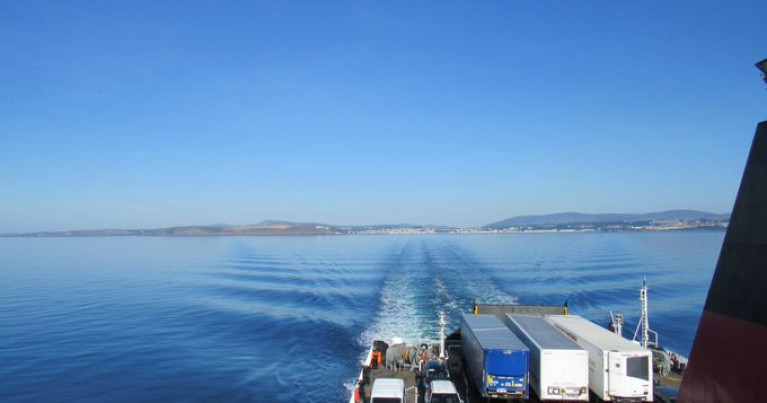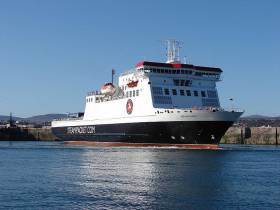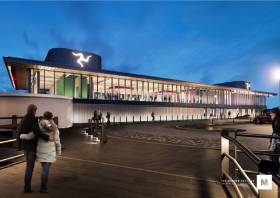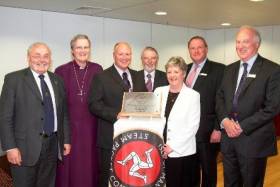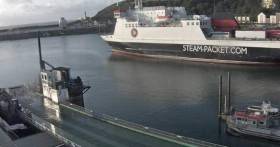Displaying items by tag: IOM Steam Packet
Isle of Man Steam Packet Loses £10.5m in 2020
The cancellation of TT and Covid restrictions have been blamed for the deficit.
As Manx Radio reports, the government-owned ferry operator lost more than £10.5 million last year.
The Isle of Man Steam Packet Company's accounts have been published ahead of this month's Tynwald sitting.
The figures show the firm lost £10,561,803 in 2020, compared to a profit of just under £10 million the year before.
The report says the cancellation of the TT, as well as ongoing Covid restrictions have had a 'very significant effect' on its income.
Further reading here including a podcast.
Senior figures in the Isle of Man Steam Packet Co.,who between them have amassed more than half a century of dedicated service to the Manx ferry company are to retire later this year.
Chief Executive Officer Mark Woodward and Commercial Director John Watt will both stand down from their roles in July 2021.
Well-respected by colleagues ashore and afloat, they have collectively chalked up 58 years during which time they have overseen a number of changes, including the acquisition of the IOM Steam-Packet by the Manx government and managing the detailed operation to secure a new purpose-built vessel, which is due to come into service in 2023.
Mark Woodward joined the Company in 1989 as Management Accountant, moving to Operations in 1995. He succeeded the late Hamish Ross as Chief Executive Officer in 2007.
At the helm for the past 14 years, during which time the Company has gone from strength-to-strength, his extensive knowledge and experience have proved invaluable, creating a strong long-term platform to deliver continued investment in sea services that meets the needs of the Island.
He commented: ‘I have been contemplating retirement for a year or so now. While I was pleased in December to be asked to stay for a few more years, ultimately the glimpse of freedom offered by working from home last year led to my final decision. I have steered the Company through both calm seas and choppy waters for 14 years now and I am happy it will be in safe hands under the Chairmanship of Lars Ugland.
‘I will, of course, miss all my colleagues and the camaraderie in the office. It has been a genuine pleasure and an honour to work for such a vital and historic Company.’
John Watt moved to the Company in 1995 and joined the Board of Directors eight years later. During his tenure, the number of passenger sailings have more than doubled, while average fares paid have halved in real terms.
He said: ‘It has been a privilege to serve this great Company over a fascinating period in its long history. In that time, fast craft has replaced conventional tonnage in some areas, special offers rather than standard fares have become the norm, the number of Liverpool services has virtually trebled and Heysham passenger services have doubled. It has been a real pleasure working for such an important Company and with such friendly and professional colleagues.’
Chairman Lars Ugland added: ‘I’d like to place on record our gratitude for both Mark and John’s long service and acknowledge the fine contribution they have made.
‘Under Mark’s leadership, the Company has made great strides to provide what is best for our Island, stabilising the long-term future of sea services for the Isle of Man and its people.
‘His quick intelligence, huge experience, sense of humour and loyalty have made him an excellent Chief Executive and he has offered a constant wise counsel, always with the best interests of the Company and the Isle of Man at heart. He will be much missed by me, the staff and the Board.
‘Likewise, John’s diligent and efficient manner has served us well and he too will be greatly missed, both on a personal level as well as for his contribution to the Company's success.’
World's Oldest Passenger Shipping Company Isle of Man Steam Packet to Celebrate 190th Birthday
Ferry operator the Isle of Man Steam Packet Company will officially mark its 190th anniversary on Tuesday (tomorrow).
It's the world’s oldest continually-operating passenger shipping company and has served the Island since 30 June 1830.
The Steam Packet, reports Manx Radio, started with a wooden paddle steamer known as Mona's Isle, built at a cost of £7,052, which was launched from Glasgow after being built on the River Clyde.
After arriving in Douglas, her maiden passenger crossing from the Isle of Man took place in mid-August that year.
To celebrate the milestone the Packet's fleet, decked in bunting, will sound its whistles in Douglas Harbour at 6pm on tomorrow evening (30 June).
Fastferry Manannan to Remain in Isle of Man for Winter Layover
The Isle of Man Steam Packet's fastferry, Manannan is to remain in Manx waters this winter.
According to EnergyFM, the passenger /vehicle craft concluded the 2019 season earlier this month, maintaining a 100% technical reliability record during the whole summer, according to the company.
Completing 759 sailings and travelling 51,777 nautical miles, the high-speed ferry also operated a 98.15% punctuality record, as the season drew to a close.
Manannan will now be moored in Douglas Harbour before undergoing an annual overhaul ahead of services resuming on 27th March next year.
Click here for more details.
Isle of Man Steam Packet: What Do You Think About A New Ferry?
The Isle of Man Steam Packet Company wants public opinion on a new ship.
The ferry operator reports Manx Radio, wants to know your thoughts, as it prepares for 'major investment in its fleet'.
The company has plans to replace the Ben-my-Chree with a purpose-built ship, designed and constructed over the next three years.
Passengers past, present and future are invited to submit their views, specifically relating to on-board facility preferences, through a survey (click here) which is being hosted by Island Global Research.
For more click here.
Liverpool's New Ferry Terminal Delayed
A completion date for the new £38m Liverpool landing stage for Isle of Man ferries has been delayed.
According to IOMToday, it will be in the summer, as the completion date for the ferry terminal was given as February 2021, but that has been put back to July of that year.
However, Infrastructure Minister Ray Harmer said he was hoping it would be ready for the TT, which gets under way at the end of May.
The delay was due to the discharge of planning conditions and some legal agreements taking ’longer than anticipated’, he said.
It was also revealed that dredging is required for the project which Afloat adds will see the Isle of Man Steam Packet use the new terminal.
For more on this development click here.
In an aim to introduce electric vehicle charging points, a campaign has been set up to apply this on board ferries of the Isle of Man Steam Packet.
David Dorricott from the Mountain View Innovation Centre based outside the (harbour town of Ramsey) wants people to be able to 'charge whilst you cross'.
He says the Island is behind other nearby companies, which have brought in ferry EV charging.
For more Manx Radio reports having contacted the Steam Packet Company for a response with a podcast available through this link.
Chairman of the Isle of Man Steam Packet to Retire
According to EnergyFM, the chairman of the Isle of Man Steam Packet Company will retire in Spring 2020 after holding his position for over 20 years.
Robert Quayle was appointed as chair in 2008 and was a director of the ferry company for more than two decades.
He will step down from his role on March 31st next year.
Mr Quayle said: ‘It has been a privilege to serve this great Company over a fascinating period in its long history. I have witnessed a number of changes of ownership during that time but the Company has continued to provide a consistent and reliable service to the Island community throughout.'
More here from the radio station.
Ferry firm the Isle of Man Steam Packet made a profit of £9.3m in the year that it was acquired by the Manx government.
But operating profits writes IOMToday, have fallen slightly.
Accounts for the Isle of Man Steam Packet Company Group Ltd for the year ending December 31, 2018, will be laid before this week’s Tynwald sitting.
They show profits for the year attributable to equity owners at £9,332,364 compared to £8,421,874 in 2017.
But operating profit, at £10,470,595, was down slightly from £10,813,574 the previous year.
The group was acquired by the Treasury on May 24 last year for a total of £124.7m, represented by debt of £75.9m and equity of £48.8m.
For more here on the accounts of the company.
Manx Government to Guarantee Isle of Man Steam Packet Loan
The Manx government will be required to guarantee the Isle of Man Steam Packet’s loans when it builds its new ferries.
Under the terms of the sea services agreement, the company must provide two new ships, with the first due to be in service in 2022.
In a Treasury report, due to be presented to Tynwald (Manx Parliament) on the refinancing of the £76m the company owes the taxpayer, it is also revealed that a government guarantee on the loans for new boats will be required.
The section of the report titled ’Additional Company Debt’ details the necessity for new ships and that ’it will require borrowing’.
For more the IOMToday reports here.



























